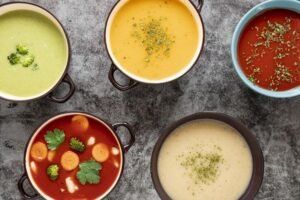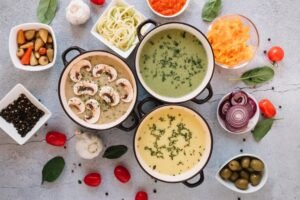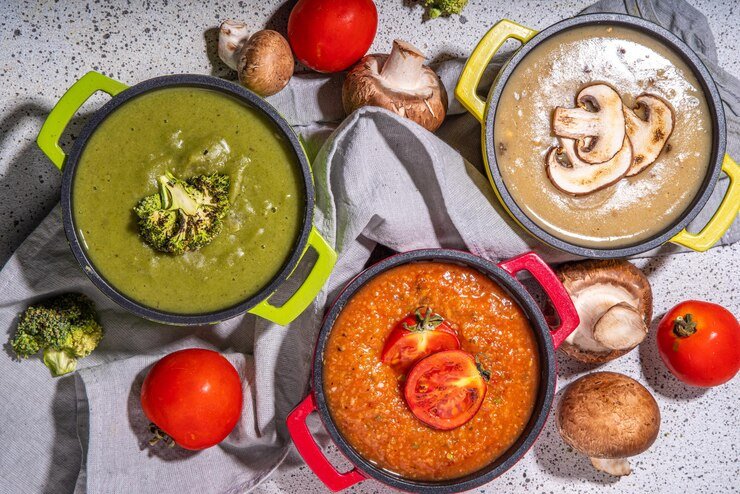What are the 4 types of soup? Soup is a culinary staple worldwide, distinguished not only by its comforting qualities but also by its cultural significance. Across different cultures, soup embodies a variety of traditions, ingredients, and cooking methods, reflecting the diversity of the regions from which they originate. From the simple broths of East Asia to the robust chowders of North America, each type of soup tells a story of cultural heritage and culinary innovation. This introduction briefly highlights the importance of soup in global cuisines and its evolution as a dish that transcends simple sustenance, setting the stage for a deeper exploration into its various forms.
Understanding the Basic Types of Soup
Soup can be categorized into several basic types, each defined by its preparation techniques and the textures and flavors it offers. This section delves into four fundamental categories: broth soups, consommés, cream soups, and velouté-based soups. We will explore the unique characteristics of each type, accompanied by classic examples that highlight their culinary roles.
Broth Soups
Broth soups are characterized by their clear, light base made from simmering meat, fish, or vegetables. This process extracts flavors, resulting in a nutritious and easily digestible soup. Popular examples include chicken noodle soup and miso soup, which are staples in many cultures due to their comforting qualities and simplicity.
Consommés
Consommés are refined broth soups that have been clarified to create a crystal-clear liquid. This is achieved through a clarification process using egg whites and lean ground meat to remove fat and sediment. Consommés are celebrated for their intense flavor and elegant presentation, with classic examples like beef consommé and tomato consommé often served in high-end dining.
Cream Soups
Cream soups are thickened with dairy products, typically cream, milk, or a roux, offering a rich and smooth texture. They often feature a main ingredient like vegetables or mushrooms, as seen in cream of mushroom or broccoli cheese soup. These soups are hearty and filling, perfect for colder weather or as a luxurious treat.
Velouté-Based Soups
Velouté-based soups start with a velouté sauce, which is one of the five mother sauces in classical cuisine, made from a light stock thickened with a blond roux. Soups like king crab velouté or turkey and wild rice soup use this base to create a creamy texture without the heaviness of cream, blending subtlety with depth of flavor.
These basic soup types form the foundation of many culinary traditions, each offering unique flavors and techniques that can be adapted and elaborated upon in countless ways.
Specialized Soup Types
As we delve deeper into the world of soups, we encounter specialized types that exhibit more complex flavors and textures, reflecting advanced culinary techniques and diverse ingredient profiles. This section explores four specialized soup categories: purée soups, bisques, chowders, and cold soups, each offering a unique culinary experience.
Purée Soups
Purée soups are thick, smooth soups made by blending cooked ingredients until they form a creamy consistency. These soups often focus on a single main ingredient like vegetables or legumes, which are cooked and then puréed with stock and seasonings. Examples include butternut squash soup and split pea soup. These soups can be enhanced with spices or garnishes like croutons or a swirl of cream to add texture and contrast.
Bisques
Bisques are rich, creamy soups traditionally made from puréed crustaceans. They are known for their smooth, velvety texture and deep flavors, achieved by simmering shells to extract maximum taste. Classic bisques include lobster bisque and shrimp bisque, often finished with a touch of cream and a splash of cognac or sherry, providing a luxurious dining experience.
Chowders
Chowders are hearty, chunky soups that usually contain seafood, potatoes, and other vegetables, thickened with cream or milk and often a roux. Originating from fishing villages in New England and the Maritime provinces of Canada, chowders like clam chowder and corn chowder are meals in themselves, known for their robust and comforting qualities.
Cold Soups
Cold soups are perfect for warm weather, offering refreshing and often tangy flavors. These soups are not cooked or are served chilled, and can be sweet or savory. Gazpacho, a tomato-based soup from Spain, and vichyssoise, a French soup made of leeks, onions, potatoes, cream, and chicken stock, are popular examples that provide a cool respite from summer heat.
Each of these specialized soup types showcases a different aspect of soup-making, from the simplicity of puréed vegetables to the luxurious richness of bisque, providing a wide range of options for both casual dining and gourmet experiences.

Practical Tips for Making Soup
What are the 4 types of soup? Making a great soup is both an art and a science, involving careful selection of ingredients, proper seasoning, and techniques to achieve the desired consistency and flavor. This section offers practical advice to help both novice and experienced cooks master the craft of soup making.
Selecting Ingredients
- Quality Matters: Always choose fresh, high-quality ingredients for the base of your soup, whether it’s vegetables, meats, or seafood. Fresh ingredients provide better flavor and nutritional value.
- Seasonal Choices: Opt for seasonal vegetables and fruits to add natural, robust flavors to your soup. Seasonal produce not only tastes better but is also generally more affordable.
- Balancing Flavors: Incorporate a variety of ingredients to balance the flavors in your soup. A mix of different vegetables, herbs, and spices can enhance the overall taste and complexity.
Seasoning Your Soup
- Layering Flavors: Build flavors by sautéing onions, garlic, and spices at the beginning. This foundation will add depth to your soup.
- Adjusting Seasonings Gradually: Season your soup in stages, not all at once, to better control the outcome. Start with a light hand and adjust as the ingredients meld together during cooking.
- Acid and Salt: Don’t forget to balance the richness of your soup with a touch of acidity from ingredients like tomatoes, lemon juice, or vinegar. Salt is essential but should be used judiciously to enhance the natural flavors of the other ingredients.
Achieving the Perfect Consistency
- Thickening Techniques: Depending on the type of soup, use appropriate thickening agents like roux, cornstarch, or pureed vegetables. For a lighter touch, a slurry of water and flour can also serve to thicken soups without adding heaviness.
- Simmering: Let your soup simmer gently rather than boil vigorously. Slow cooking helps flavors to develop fully and ingredients to soften perfectly without breaking down too much.
- Blending: For smooth soups, use a blender or an immersion blender to puree the soup to the desired texture. Make sure to blend hot soups carefully to avoid splatters.
With these tips, you can enhance your soup-making skills, ensuring delicious results that are tailored to your taste preferences and culinary style. Whether aiming for a light broth or a thick, creamy soup, the key is in the details of preparation and cooking.
The Nutritional Benefits of Soup
Soups provide comfort and a wealth of nutrients. This section explores their health benefits and healing properties.
Broth-Based Soups
Broth-based soups are rich in minerals and collagen. Bone broth supports joints, digestion, and skin health. Vegetable broths offer essential nutrients and antioxidants, aiding hydration and recovery with few calories.
Creamy Soups
Creamy soups are great sources of calcium and vitamins D and A. They support bone health and the immune system. However, they can be calorie-dense, so watch portion sizes.
Soups with Legumes and Grains
These soups are hearty and nutritious. They provide plant-based protein and fiber, supporting muscle repair and digestive health. Ingredients like beans, lentils, and barley are especially beneficial.
Cold Soups
Cold soups like gazpacho are perfect for hydration and cooling down. They preserve the nutrients of raw vegetables and fruits, offering vitamins and antioxidants during warm weather.
This overview highlights soups’ roles in a nutritious diet and showcases their versatility in both taste and health benefits.
The Art of Soup Pairings
Enhancing your soup experience involves more than just crafting a delicious bowl; it’s about creating a complete and harmonious meal. This section explores the art of pairing soups with appropriate sides, wines, and desserts to elevate your dining experience, whether it’s a casual lunch or an elegant dinner party.
Bread Pairings
Bread and soup are a timeless combination. For a robust choice like French onion soup, a crusty baguette is ideal for soaking up the rich broth. Conversely, a slice of dense rye bread pairs beautifully with the earthy tones of beetroot soup. These pairings not only complement the flavor profiles but also add a satisfying textural contrast to the meal.
Salad Pairings
Balancing a hearty soup with a light, fresh salad can turn a simple meal into a well-rounded feast. For creamy soups, consider a crisp green salad dressed with a vinaigrette to cut through the richness. Include ingredients like fresh herbs, nuts, or citrus to match the depth of the soup and refresh the palate.
Wine Pairings
Choosing the right wine can enhance both the soup and the wine itself. A light, crisp white wine, such as a Sauvignon Blanc, complements creamy soups like chowders or bisques without overpowering them. For heartier, meat-based stews or soups, a fuller-bodied red wine, such as a Cabernet Sauvignon, supports the dish’s robust flavors.
Dessert Pairings
Concluding a meal with a dessert that complements your soup can enhance the overall dining experience. After a spicy soup, a sweet and creamy dessert like a mousse or panna cotta can soothe the palate. For lighter, vegetable-based soups, a fruit tart or sorbet might provide the perfect refreshing finish.
This section not only offers practical advice on how to create delightful pairings but also emphasizes the importance of considering all elements of a meal to ensure each course complements the others beautifully. By paying attention to these details, you can turn a simple soup into a memorable culinary event.
FAQs
What are the 4 types of soup? Soups are as diverse and complex as the cultures they come from, and they often bring up common questions about their preparation and distinction. This section addresses frequently asked questions derived from common inquiries found in the ‘people also ask’ section on Google.
What is the difference between broth and stock?
Broth and stock are both foundational elements in cooking, but they differ primarily in their ingredients and cooking time. Broth is typically made by simmering meat (often with some bones) and vegetables, while stock is made primarily from bones, which are simmered for a longer period to extract collagen. This gives stock a richer, more gelatinous consistency, ideal for adding body to dishes. Broth tends to be lighter and is often seasoned to be enjoyed on its own.
How do you clarify a consommé?
Clarifying a consommé involves a process known as raft making, where a mixture of egg whites and lean ground meat is used to trap impurities. This mixture is stirred into the broth, which is then slowly brought to a simmer. As it heats, the egg whites and meat coagulate into a floating « raft, » which attracts and traps fine particles and fats. The clear liquid is then carefully strained away from the raft, resulting in a beautifully transparent and refined consommé.
What makes a soup a bisque?
A bisque is a type of soup that is smooth, creamy, and highly seasoned, traditionally made from crustaceans like lobster, crab, shrimp, or crayfish. What sets bisque apart is the method of sautéing the ingredients in their shells, then simmering them to extract full flavor, which is then pureed into a fine consistency. Cream, butter, and sometimes sherry are added to create a rich and luxurious texture and flavor. Bisques are part of French cuisine but have gained popularity worldwide for their depth and elegance.

Recommended Internal Links
- Ultimate Potato Soup
- Embedding Phrase: « velouté-based soups »
- Internal Link: Ultimate Potato Soup
- Context: When discussing velouté-based soups, you can link to this recipe as a practical example of a velouté soup using potatoes.
- Tomato Cream Sauce for Pasta
- Embedding Phrase: « cream soups »
- Internal Link: Tomato Cream Sauce for Pasta
- Context: In the section about cream soups, this link can serve as an example of how the creamy texture is used in other recipes, such as sauces.
- Crema de Brocoli
- Embedding Phrase: « pureed soups »
- Internal Link: Crema de Brocoli
- Context: This recipe can be linked when discussing the nutritional benefits and preparation methods of pureed soups, specifically highlighting a popular vegetable-based option.
Additional Resources and Readings
-
- Zero-Waste Chef:
-
-
- Embedding Phrase: « reducing food waste with soup »
- External Link: Zero-Waste Chef – No Waste Soup
- Context: This link can be included in the section discussing the environmental benefits of soup, emphasizing how soup can be used as a strategy to reduce food waste.
- Food Timeline:
- Embedding Phrase: « historical evolution of soups »
- External Link: History Notes on Soup
- Context: In the introduction or wherever the history of soup is discussed, this link provides readers with a detailed look at the origin and evolution of soups through time.
- AARP:
- Embedding Phrase: « no-cook soup recipes »
- External Link: No-Cook Soup Recipes – AARP
- Context: In the section on cold soups, this link could provide readers with easy options for refreshing dishes that do not require cooking, enhancing the variety of soup types discussed.
-
Conclusion
What are the 4 types of soup? Soups, with their profound versatility and broad appeal, occupy a special place in global cuisines. They can be light and invigorating or rich and hearty, catering to diverse tastes and dietary requirements. Throughout this exploration, we’ve seen how soups serve not only as a reflection of cultural identity but also as a showcase of culinary creativity, with techniques ranging from simple broths to complex consommés and innovative cold soups. As we wrap up, it’s clear that the world of soups is vast and varied, offering endless possibilities for customization and experimentation. Whether as a starter, a main dish, or a soothing remedy, soups continue to be a cornerstone of good eating around the world.

